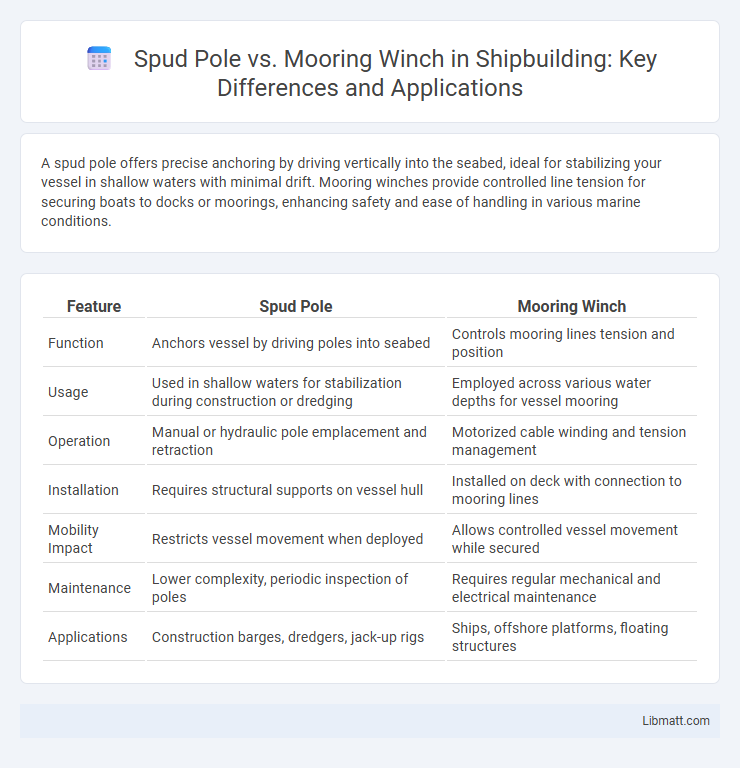A spud pole offers precise anchoring by driving vertically into the seabed, ideal for stabilizing your vessel in shallow waters with minimal drift. Mooring winches provide controlled line tension for securing boats to docks or moorings, enhancing safety and ease of handling in various marine conditions.
Table of Comparison
| Feature | Spud Pole | Mooring Winch |
|---|---|---|
| Function | Anchors vessel by driving poles into seabed | Controls mooring lines tension and position |
| Usage | Used in shallow waters for stabilization during construction or dredging | Employed across various water depths for vessel mooring |
| Operation | Manual or hydraulic pole emplacement and retraction | Motorized cable winding and tension management |
| Installation | Requires structural supports on vessel hull | Installed on deck with connection to mooring lines |
| Mobility Impact | Restricts vessel movement when deployed | Allows controlled vessel movement while secured |
| Maintenance | Lower complexity, periodic inspection of poles | Requires regular mechanical and electrical maintenance |
| Applications | Construction barges, dredgers, jack-up rigs | Ships, offshore platforms, floating structures |
Introduction: Spud Pole vs Mooring Winch
Spud poles provide precise, mechanical positioning for barges by anchoring directly into the seabed, offering stability in shallow waters and during operations like dredging. Mooring winches control and adjust mooring lines, ensuring vessel stability by managing tension and accommodating movement from tides and currents. Choosing between a spud pole and mooring winch depends on operational needs, water depth, and environmental conditions.
Definitions and Basic Functions
A spud pole is a vertical steel or aluminum beam used to anchor a barge or work platform to the seabed for stability during operations like dredging or construction. A mooring winch is a mechanical device designed to control the tension and length of mooring lines or ropes, securing vessels to docks or anchors. While the spud pole provides direct seabed anchoring by penetrating the bottom, the mooring winch regulates the positioning and holding power through controlled line handling.
Key Differences Between Spud Poles and Mooring Winches
Spud poles are vertical steel piles used to anchor barges firmly to the seabed, providing stability in shallow waters, while mooring winches are mechanical devices designed to deploy, retrieve, and adjust mooring lines or anchors on various vessels. Spud poles offer fixed positioning with minimal equipment operation, ideal for stationary tasks, whereas mooring winches provide flexibility and control for dynamic mooring situations, enabling you to quickly respond to changes in tide or current. Understanding these key differences helps optimize your marine operations based on stability needs and maneuverability requirements.
Applications in Marine Operations
Spud poles provide precise stability for barges and floating platforms during dredging and construction activities in shallow waters, ideal for maintaining position without anchoring. Mooring winches are essential for securing vessels to docks or anchors, offering controlled tension management in dynamic marine environments such as ports and offshore installations. Your choice between a spud pole and a mooring winch depends on the specific operational need for either fixed positioning or flexible mooring in marine operations.
Advantages of Spud Poles
Spud poles offer precise and stable positioning for barges and vessels, enabling effective control in shallow or environmentally sensitive waters. Their mechanical simplicity reduces maintenance costs and risk of mechanical failure compared to mooring winches. You benefit from enhanced operational safety and reliability when using spud poles in offshore and nearshore applications.
Advantages of Mooring Winches
Mooring winches offer precise control over vessel positioning, allowing smooth adjustments in response to tidal changes and current shifts. These winches reduce manual labor and enhance safety by automating anchor handling and line tension management. Your operations benefit from increased efficiency and reliability compared to traditional spud pole setups.
Limitations of Each System
Spud poles provide reliable stability in shallow waters but are limited by their depth range and difficulty in deployment during strong currents or rough seas. Mooring winches offer greater flexibility and ease of adjustment for various water depths, yet they require regular maintenance and can suffer mechanical failures under heavy load conditions. Understanding your vessel's operational environment helps determine whether the fixed support of a spud pole or the dynamic tension control of a mooring winch best suits your needs.
Factors to Consider When Choosing
Choosing between a spud pole and a mooring winch depends on factors such as the water depth, seabed composition, and vessel size. Spud poles are ideal for shallow waters with soft bottoms, offering stability by penetrating the seabed, while mooring winches work better in deeper or varied seabed conditions by securing mooring lines. Your choice should also consider maintenance requirements, operational complexity, and the specific environmental conditions of your navigation area.
Industry Use Cases and Examples
Spud poles are extensively utilized in shallow-water construction and dredging projects, providing stable support for barges during pile driving and marine infrastructure installation. Mooring winches are essential in offshore oil and gas platforms, allowing precise mooring line tension control to secure floating rigs amidst dynamic ocean conditions. Both technologies are critical in port operations, with spud poles enabling temporary anchoring for maintenance vessels and mooring winches facilitating the safe docking of large container ships.
Conclusion: Choosing the Right Solution
Selecting between a spud pole and a mooring winch depends on factors such as water depth, vessel size, and operational requirements. Spud poles offer precise positioning and stability in shallow waters, while mooring winches provide flexibility and easier handling in deeper or dynamic environments. Evaluating site conditions and vessel capabilities ensures the optimal choice for secure anchoring and efficient mooring operations.
Spud pole vs mooring winch Infographic

 libmatt.com
libmatt.com